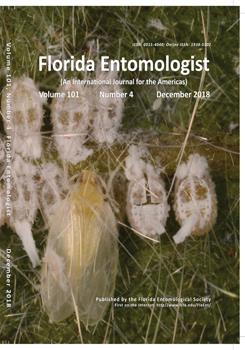Xyleborus volvulus is a polyphagous beetle that can carry Raffaelea lauricola, a phytopathogenic fungus that causes laurel wilt disease. In Mexico, the insect has been associated with damage to cedar, cacao, and avocado plantations. Here, we report mango trees infested by X. volvulus in a mango orchard with a history of having avocado trees were removed due to infestation by X. volvulus.
Ambrosia beetles are a natural part of the wood decomposition processes in ecosystems; however, some exotic species can cause serious problems in economically important crops, or seriously threaten native plant species (Sobel et al. 2015). Outstanding examples confirming this are the introduction of Xyleborus glabratus Eichhoff (Coleoptera: Curculionidae: Scolytinae) and Euwallacea sp. (Coleoptera: Curculionidae: Scolytinae) ambrosia beetles (Pisani et al. 2015), native to Asia, but introduced into the USA near Savannah, Georgia. This has resulted in the death of more than 500 million trees of the family Lauraceae (Peña et al. 2012), including avocado trees, Persea americana Miller (Lauraceae). These beetles are characterized by their symbiotic and nutritional relationship with fungi that grow on the walls of their galleries, which are located in the xylem of host trees (Hughes et al. 2015). The fungal growth inside the vascular system of living trees hinders the flow of water and nutrients, resulting in injury or mortality of many host plant species in a short period of time (Fraedrich et al. 2008). The X. glabratus beetle transmits the fungus Raffaelea lauricola TC Harr., Fraedrich & Aghayeva (Ophiostomatales: Ophiostomataceae), that causes an affliction known as laurel wilt disease (Harrington et al. 2008). A second exotic species is the polyphagous shot hole borer Euwallacea sp., an ambrosia beetle that transmits the fungi Fusarium euwallaceae (S. Freeman, Z. Mendel, T. Aoki & O'Donnell), Graphium euwallaceae (Twizeyimana, S.C. Lynch & Eskalen), and Acremonium pembeum (S. C. Lynch & Eskalen) that commonly cause “fusarium dieback” in many plant species.
The presence of E. nr. fornicatus has been reported in host plants throughout the city of Tijuana, Baja California, Mexico (García-Avila et al. 2016). However, the presence of X. glabratus has not been reported in Mexico (SENASICA 2017).
In relation to the X. glabratus symbiont, R. lauricola can be carried by secondary vectors, thus facilitating the spread of the disease. Among the secondary vectors, X. volvulus (Eichhoff) stands out because in laboratory tests it has been demonstrated that it can transmit R. lauricola to avocado. Thus, the possibility of this occurring in the field cannot be discarded (Carrillo et al. 2014). Recently, the presence of X. volvulus was observed in avocado trees in Colima, Mexico (Castrejón-Antonio et al. 2017), and another report indicates its ability to infest Mexican cedar trees (Cedrela odorata L.) and cacao (Theobroma cacao L.) (Pérez-De la Cruz et al. 2009; Rangel et al. 2012).
Since Apr 2015, periodic observations have been made in a mango orchard (Mangifera indica L., var ‘Ataulfo’) (Anacardiaceae) in association with avocado (var ‘Mendez’) in Manzanillo, Colima, Mexico (19.02663°N, 104.09755°W, 23 m asl); the avocados were felled in Mar 2016 after being damaged by ambrosia beetles (Castrejón-Antonio et al. 2017). In Apr 2017, during a survey in the same orchard, mango trees with leaf wilt throughout the canopy, ambrosia beetle galleries and frass on the main trunk were observed (Fig. 1). Pieces of wood were collected and placed in emergence chambers (26 °C, 60% RH, 14:10 [L:D] photoperiod). The insects that emerged from the wood were collected, assembled, labeled, and sent to the Departamento de Entomología y Acarología del Centro Nacional de Referencia Fitosanitaria (CNRF) de la Dirección General de Sanidad Vegetal (SENASICASAGARPA) for identification. The beetles were identified using the taxonomic keys described by Wood (1982), as Hypocryphalus mangiferae Stebbing and Xyleborus volvulus F. (Fig. 2).
The mango tree is known to be a host of X. volvulus (Atkinson 2017); however, damage by this beetle had not been reported previously in Mexico. The case described here demonstrates the susceptibility of the mango tree to X. volvulus. Furthermore, this particular case also demonstrates that ambrosia beetles can infest 1 host tree species and migrate to other host species trees in a 2-cultivar orchard.
Acknowledgments
To “Comité Estatal de Sanidad Vegetal del Estado de Colima (CESAVECOL)” for providing facilities and access to vegetable gardens; to Ing. Rigoberto González Gómez and Biol. Nallely Acevedo Reyes of “Centro Nacional de Referencia Fitosanitaria (Dirección General de Sanidad Vegetal- SENASICA)” for their support identifying beetle samples; and finally the authors also would like to thank Jr. Spec. Adrian Poloni for suggestions to improve the manuscript.







